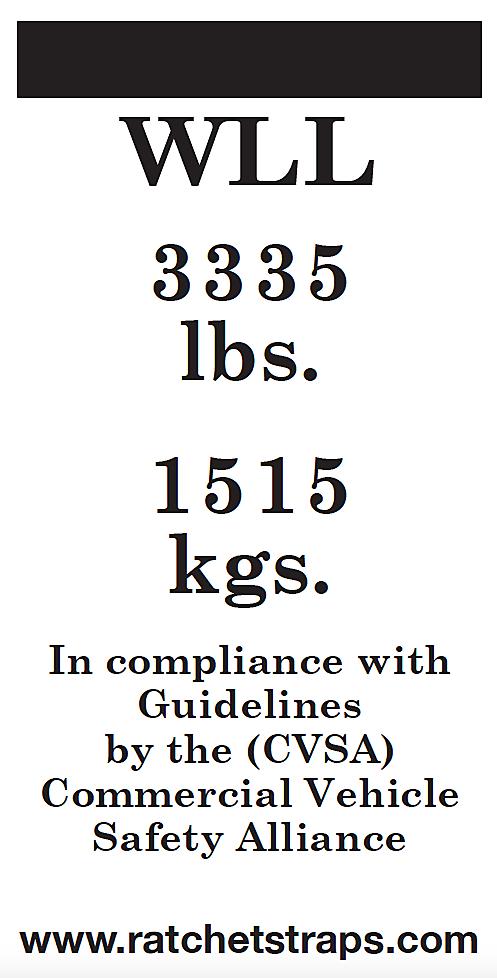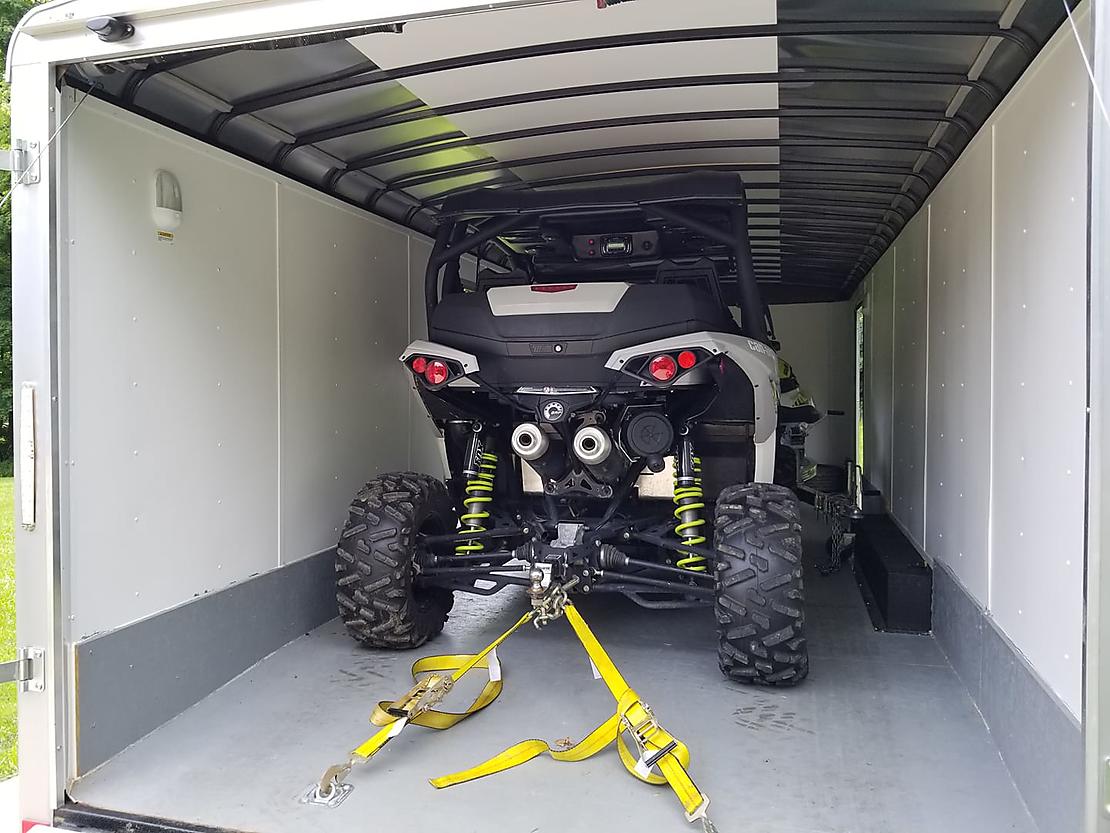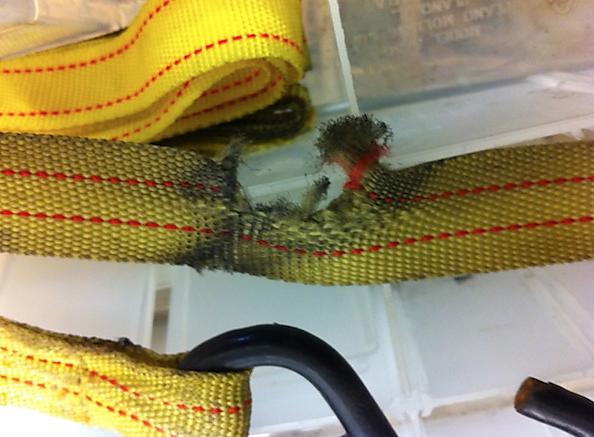
What is a Ratchet Strap?
A ratchet strap, also known as a cargo strap or tie-down strap, is a length of webbing with a ratcheting mechanism attached to one or both ends. The webbing is typically made of synthetic materials, such as nylon or polyester, and is designed to be strong and durable. The ratcheting mechanism allows the strap to be tightened securely around an object and then locked into place, preventing the strap from slipping or becoming loose.
Ratchet straps are commonly used to secure items during transport, such as on a trailer, in the bed of a truck, or on a roof rack. They are also used in other applications where it is important to secure items firmly in places, such as in construction, cargo handling, and storage.


Photos used with permission from RatchetStraps.Info
How to Tighten a Ratchet Strap Instructions
1). Begin by securing one end of the strap to a stationary object, such as the frame of a trailer or the bed of a truck.
2). Wrap the strap around the item you want to secure, making sure that the strap is positioned so that it will not slip or become loose during transport.
3). Thread the other end of the strap through the ratcheting mechanism, making sure that the webbing is properly aligned with the mechanism.
4). Pull the strap tight to apply tension to the webbing.
5). Use the ratcheting mechanism to secure the strap in place by turning the handle or lever until the strap is tight and the mechanism locks into place.
6). Repeat the process with additional straps as needed to secure the item firmly in place.
Note that it is important to always use the ratcheting mechanism properly and to avoid overtightening the strap, as this can cause the webbing to stretch or break. It is also important to regularly inspect the straps for any signs of damage or wear and to replace any straps that show any signs of weakness or failure. You can view our full guide on how to use a ratchet strap in our How to inspect your Ratchet Straps blog post.

How to Release a Ratchet Strap Instructions
1). Locate the release mechanism on the ratcheting mechanism. This is typically a button or lever that can be pressed or pulled to release the mechanism.
2). Activate the release mechanism by pressing or pulling on it. This will unlock the ratcheting mechanism and allow the strap to slide freely through it.
3). Pull on the webbing to slacken it and then slide the ratcheting mechanism along the webbing to release the tension. It may be necessary to use the release mechanism multiple times to completely loosen the strap.
4). Once the strap is loose, it can be removed from the item and the anchor point.
Always follow the manufacturer’s instructions for releasing the ratcheting mechanism, as the specific procedure may vary depending on the type of ratchet strap you are using. It is also important to use the release mechanism carefully to avoid damaging the ratcheting mechanism or the webbing.

How to Secure a Vehicle Using Ratchet Straps
To secure a car to a trailer using ratchet straps, follow these steps:
1). Begin by positioning the trailer next to the car, with the rear of the car aligned with the loading ramp or deck of the trailer.
2). Next, attach one end of a ratchet strap to the front of the car, near the bumper or frame. Use a D-ring, hook, or other suitable anchor points on the car for attaching the strap.
3). Run the strap diagonally across the front of the car and attach the other end of the strap to the trailer, using a D-ring, hook, or other suitable anchor points on the trailer.
4). Pull the strap tight and use the ratcheting mechanism to secure the strap in place.
5). Repeat the process with additional straps at the rear of the car, attaching one end to the rear bumper or frame and the other end to the trailer.
6). Once all of the straps are in place and tightened, carefully drive the car up the ramp and onto the trailer. Once the car is securely on the trailer, use additional straps to secure the car to the trailer, attaching the straps to the frame or other suitable anchor points on the car and the trailer.
7). Tighten all of the straps until the car is securely fastened to the trailer.

What is a Working Load Limit?
The working load limit (WLL) of a ratchet strap, or any other type of load-bearing equipment, is the maximum load or weight that the strap is designed to safely support under normal working conditions. The WLL is typically expressed in pounds or kilograms and is determined by the manufacturer based on the strength of the materials used to make the strap and the design of the strap.
The breaking strength of a material is an important factor to consider when selecting a product for a particular application, as exceeding the breaking strength can cause the material to break or fail, potentially leading to injury or damage. It is important to always use a product with a breaking strength that is appropriate for the intended application and to avoid exceeding the breaking strength.
It is important to always use a ratchet strap with a WLL that is appropriate for the load you are securing, as exceeding the WLL can cause the strap to break or fail, potentially leading to injury or damage. Always check the WLL of a ratchet strap before using it and do not exceed the WLL.

Frequently Asked Ratchet Strap Questions
How Long Do Ratchet Straps Generally Last? – The lifespan of a ratchet strap depends on a number of factors, including the quality of the strap, the type of materials used, the WLL, and how the strap is used and stored. In general, well-made ratchet straps can last for many years if they are used and stored properly.
However, ratchet straps are subject to wear and tear, and their strength can be reduced over time due to factors such as UV exposure, extreme temperatures, and repeated use. It is important to regularly inspect ratchet straps for signs of damage or wear and to replace straps that show any signs of weakness or failure.

How Do You Inspect Ratchet Straps for Damage? – To inspect a ratchet strap for damage, first check the webbing for any cuts, tears, or fraying. The webbing should be free of any defects and should be uniform in color and texture. Next, inspect the ratcheting mechanism for any signs of damage, such as bent or broken parts, or any other abnormalities.
The ratcheting mechanism should operate smoothly and securely without any binding or slipping. Finally, inspect the ends of the strap, including the hardware, such as hooks, D-rings, or buckles, for any signs of damage or wear. The hardware should be securely attached to the strap and should not show any signs of bending, cracking, or other damage. If you notice any damage to the strap, it should be replaced immediately.
How Many Ratchet Straps Should You Use? – The number of ratchet straps you should use depends on the size and weight of the item you are securing, as well as the WLL of the straps you are using. As a general rule, you should use at least two ratchet straps to secure an item, with one strap at each end of the item.
For larger or heavier items, you may need to use additional straps to distribute the load evenly and to prevent the item from shifting or becoming loose during transport. It is also important to use ratchet straps with a WLL that is appropriate for the load you are securing. Always refer to the manufacturer’s instructions or guidelines for specific recommendations on the number and type of ratchet straps to use for a particular application.

What is the type of Tie Down Webbing used on Ratchet Straps? – Polyester Tie Down Webbing is the webbing blend of choice for almost all tie-down straps in the United States. Polyester is a strong and durable synthetic material, and polyester tie-down webbing is known for its high tensile strength and resistance to UV light, moisture, and abrasion.
It is also lightweight and flexible, making it well-suited for use in a variety of tie-down applications. Additionally, polyester tie-down webbing is often more affordable than other types of webbing materials, such as nylon.
What Applications Can You Use Ratchet Straps On? – Ratchet straps are commonly used to secure items during transport, such as on a trailer, in the bed of a truck, or on a roof rack. They are often used to tie down motorcycles, ATVs, boats, and other large or heavy items to prevent them from moving around or falling off during transit. Ratchet straps are also used in other applications where it is important to secure items firmly in places, such as in construction, cargo handling, and storage.